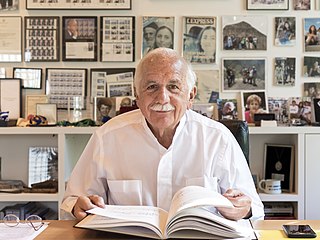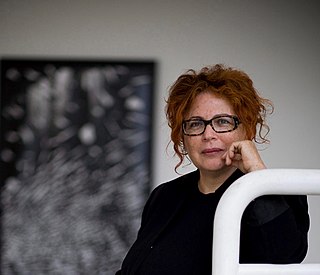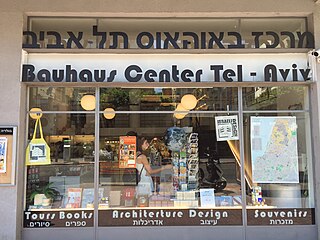Preston Scott Cohen is a professor of Harvard Graduate School of Design (GSD). [1] In 2004, he established a partnership with two registered architects, Amit Nemlich and Gilles Quintal, and became the Design Principal of Preston Scott Cohen, Inc. based in Central Square Cambridge, Massachusetts. [2] Preston Scott Cohen, Inc. is renowned for the design of cultural, educational, commercial buildings and urban design projects around the world. Projects include the Sarmiento Performing Arts Center in Bogota, Colombia; a new building for Taubman College at the University of Michigan; the Taiyuan Museum of Art in Taiyuan, China; the Datong City Library; the Amir Building, Tel Aviv Museum of Art; and the Goldman Sachs Canopy in New York. The firm is also well known for non-profit projects including the Cape Rep Theater, Temple Beth El in Springfield, MA, and the Detroit Chabad. Cohen has received numerous honors including induction as an academician at the National Academy of Art, five Progressive Architecture Awards, first prizes for seven international competitions and an Academy Award from the American Academy of Arts and Letters. Cohen is the author of Lightfall (Skira Rizzoli, 2016), The Return of Nature (2015), Contested Symmetries (2001), and numerous theoretical essays on architecture. His work has been widely exhibited and is held in numerous museum collections.

Richard Meier is an American abstract artist and architect, whose geometric designs make prominent use of the color white. A winner of the Pritzker Architecture Prize in 1984, Meier has designed several iconic buildings including the Barcelona Museum of Contemporary Art, the Getty Center in Los Angeles, and San Jose City Hall.

Moshe Safdie is an architect, urban planner, educator, theorist, and author who claims Israeli, Canadian and American citizenship. Over a 50-year career, Safdie has explored the essential principles of socially responsible design through a comprehensive and humane design philosophy. Safdie is an important architect of the second half of the twentieth and early twenty-first century because of his multiculturalism, commitment to geographic, social and cultural elements that define a place, and constant search for typological and technological innovation. Coiner of the phrase "For Everyone a Garden,", Safdie completed projects that include cultural, educational, and civic institutions; neighborhoods and public parks; housing; mixed-use urban centers; airports; and master plans for both existing communities and entirely new cities. Safdie has had projects in North and South America, the Middle East, and throughout Asia. He is most identified with designing Marina Bay Sands and Jewel Changi Airport, as well as his debut project, Habitat 67, originally conceived as his master's thesis at McGill University. This led to his international career. Safdie is considered a thought leader and his exemplary projects have been inspired generations of architects and architecture.

Peter Eisenman is an American architect. Considered one of the New York Five, Eisenman is known for his writing and speaking about architecture as well as his designs, which have been called high modernist or deconstructive.

Tel Aviv Museum of Art is an art museum in Tel Aviv, Israel.

The Harvard Graduate School of Design (GSD) is a graduate school of design at Harvard University. Located in Cambridge, Massachusetts, the GSD offers master's and doctoral programs in architecture, landscape architecture, urban planning, urban design, real estate, design engineering, and design studies.

Daniel Urban Kiley was an American landscape architect, who worked in the style of modern architecture. Kiley designed over one-thousand landscape projects including Gateway Arch National Park in St. Louis.

Zvi Hecker is a Polish-born Israeli architect. His work is known for its emphasis on geometry and asymmetry.

The White City is a collection of over 4,000 buildings built in a unique form of the International Style in Tel Aviv from the 1930s, with a strong Bauhaus component, by Jewish architects from Germany and other Central and East European countries with German Cultural influences, who immigrated to the British Mandate of Palestine after the rise to power of the Nazis in Germany. Tel Aviv has the largest number of buildings in the Bauhaus/International Style of any city in the world. Preservation, documentation, and exhibitions have brought attention to Tel Aviv's collection of 1930s architecture. In 2003, the United Nations Educational, Scientific and Cultural Organization (UNESCO) proclaimed Tel Aviv's White City a World Cultural Heritage site, as "an outstanding example of new town planning and architecture in the early 20th century." The citation recognized the unique adaptation of modern international architectural trends to the cultural, climatic, and local traditions of the city. Bauhaus Center Tel Aviv organizes regular architectural tours of the city.

Deconstructivism is a movement of postmodern architecture which appeared in the 1980s. It gives the impression of the fragmentation of the constructed building, commonly characterised by an absence of obvious harmony, continuity, or symmetry. Its name is a portmanteau of Constructivism and "Deconstruction", a form of semiotic analysis developed by the French philosopher Jacques Derrida. Architects whose work is often described as deconstructivist include Zaha Hadid, Peter Eisenman, Frank Gehry, Rem Koolhaas, Daniel Libeskind, Bernard Tschumi, and Coop Himmelb(l)au.
Eric Owen Moss practices architecture with his eponymously named LA-based firm founded in 1973.

Maya Cohen Levy, also known as Maya Cohen-Levy, is an Israeli painter and sculptor.

Pinchas Cohen Gan is an Israeli painter and mixed-media artist. He was awarded the Sandberg Prize (1979), the Culture and Sport Ministry's prize for his life's work (2005), and the Israel Prize in Art (2008).

The Cymbalista Synagogue and Jewish Heritage Center is a cultural center and the main synagogue of Tel Aviv University. It was designed in 1996 by architect Mario Botta and constructed from 1997 to 1998. The patrons and namesakes were Paulette and Norbert Cymbalista.

Bauhaus Center Tel Aviv is an organization concerned with Bauhaus architecture and design in the city of Tel Aviv, Israel. Buildings designed in the International Style, commonly known as Bauhaus, comprise most of the center of Tel Aviv known as The White City. The vision behind the Center is to raise awareness of the Bauhaus heritage and be part of the cultural and artistic development in Tel Aviv.

Wesley Jones is an American architect, educator and author. Founding partner of Holt Hinshaw Pfau Jones, in 1987 and then Jones, Partners: Architecture in 1993, Jones is a leading architectural voice of his generation, advocating for a continuing appreciation of the physical side of technology within a world increasingly enamored of the virtual. For most of his career this has taken the form of an overt fascination with mechanical expression, both static and moving, and his designs have been celebrated for their "engaging operability” and humor. In his early writings he focused on making the case for the appropriateness of mechanical form in architecture, but his later essays have also taken on more fundamental disciplinary questions, particularly with respect to the growing hegemony of digital design.
Mirit Cohen was a Russian-born Israeli sculptor and painter. Cohen resided in New York City from 1975. In 1990, she committed suicide.

Nahum Zolotov was an Israeli architect and a recipient of the Rokach Prize in 1961 and in 1973. He was a recipient of the Rechter Prize.

Moti Bodek is an Israeli architect, the owner of the firm Bodek Architects based in Tel Aviv, and a senior lecturer at the Architecture department in Bezalel Academy of Art and Design, Jerusalem.
Yaakov Rechter was an Israeli architect and an Israel Prize recipient.

Miki Kratsman is an Israeli photographer, photojournalist and activist.

















